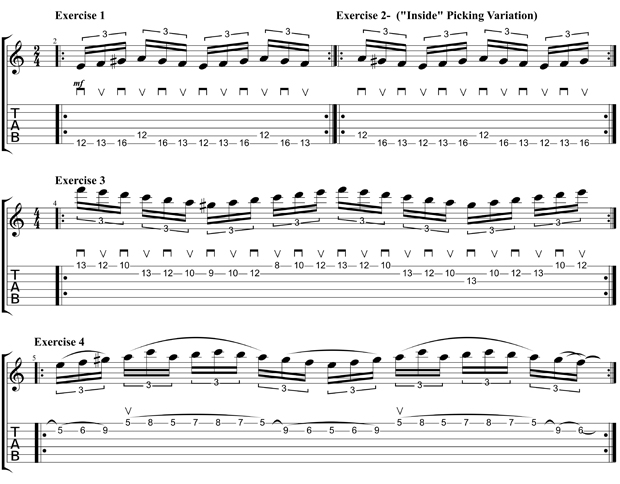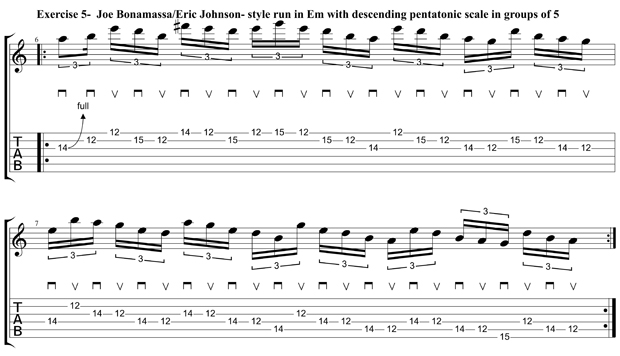How Guitarists Can Break Through Speed Barriers
This trick will let you break through speed barriers that have been holding you back from attaining your true technical potential.

The art of properly practicing technical passages on the guitar has many parallels to athletic training in its way, as it is a physical endeavor requiring repetition and focused execution of muscular movements with the goal of consistent improvement.
To this end, I’d like to share a trick borrowed from the world’s elite speed- and strength-training athletes that will help you get the maximum intensity from your guitar workouts in the minimum amount of time. It also will let you break through speed barriers that have been holding you back from attaining your true technical potential.
There are plenty of scientific terms to describe the process involved such as “stimulating the adaptation response” and “priming the neuromuscular junction,” but the technique is simple: If your goal is to cleanly perform an exercise at 105 bpm (See the exercises at the end of this piece for some short, “skill specific” examples) and your current maximum speed is 100 bpm, you will break up your workout with the particular exercise into the following five “sets”:
Set 1
Warm-up, 60 percent of max (60 bpm): With a metronome or drum machine/program, perform the exercise or etude slowly and methodically. Emphasize relaxed, economical movement with precise, articulate execution. Repeat the exercise continuously for 1 minute without stopping or pausing between repeats.
Set 2
Working set, 85 percent of max (85 bpm): After resting for a minute, increase the speed and play the exercise for 45 seconds. Once again, pay attention to consistent mechanical perfection through relaxed movement. Make sure your tone is smooth and even and that you are perfectly synchronized with the beat.
Set 3
Max set, 100 percent of max (100 bpm): Rest another minute and then increase the speed to your initial maximum. Perform the exercise for as long as you can with consistent timing, articulation and tone (Make note of how long you were able to keep up the pace, and be sure to set out to outperform yourself the next time you try cycling through this workout!). Many guitarists breathe unevenly during exercise levels of this intensity, so pay extra attention to maintaining an even breath flow throughout (in through your nose, out through your mouth). Continue at this step until you can repeat the exercise perfectly for at least 30 seconds.
Set 4
OVERLOAD set, 110 percent of max (110 bpm): You should be quite pumped by this point and feeling a burn in your forearm muscles, so rest for a minute (but no more!) before raising the speed again. (Warning: Never play through sharp pain! A good “burn” and/or light fatigue are perfectly normal, but stop the instant you feel intense pain.)
All the latest guitar news, interviews, lessons, reviews, deals and more, direct to your inbox!

During your rest period, set the tempo to this 110 percent speed and listen intently to the beat. Mentally recall and visualize the peak performance moments of your previous sets, “hear” yourself performing the exercise at this tempo, and envision yourself playing with the same perfection and focus of the earlier sets with heightened intensity. Play the exercise at the new tempo and push yourself with all of your inner-strength to keep up with the beat.
Even though you won’t keep perfect time and your technique will undoubtedly become less accurate (“She’s breaking up, Captain!”), do your best to maintain pace and do not stop for 30 seconds.
Set 5
New Max, 105 percent of previous max (105 bpm): Without resting between sets, you should be able to perform the exercise with the same accuracy and relaxed intensity that you had during set 3, but at a new top speed!

This technique should be used sparingly when the usual “incremental increase” style practice sessions seem to no longer be yielding any gains, or when you just want to get a quick boost with a particularly troublesome/frustrating lick.
Try this workout with your favorite licks and exercises (I recommend all of the short exercises in Paul Gilbert’s Intense Rock 1+2 DVD set) and the exercises above. Happy shredding!
Scott Marano has dedicated his life to the study of the guitar, honing his chops at the Berklee College of Music under the tutelage of Jon Finn and Joe Stump and working as an accomplished guitarist, performer, songwriter and in-demand instructor. In 2007, Scott developed the Guitar Strength program to inspire and provide accelerated education to guitarists of all ages and in all styles through state-of-the-art private guitar lessons in his home state of Rhode Island and globally via Skype. Visit Scott and learn more at GuitarStrength.com.
Scott Marano has dedicated his life to the study of the guitar, honing his chops at the Berklee College of Music under the tutelage of Jon Finn and Joe Stump and working as an accomplished guitarist, performer, songwriter and in-demand instructor. In 2007, Scott developed the Guitar Strength program to inspire and provide accelerated education to guitarists of all ages and in all styles through state-of-the-art private guitar lessons in his home state of Rhode Island and globally via Skype.
